This article may contain affiliate links.
Updated: 18 January, 2025
What to see when visiting the David Gareja Monastery, the nearby monasteries and the rainbow mountains, with alternatives to get there.
The David Gareja Monastery on the border of Georgia and Azerbaijan is considered one of the wonders of the world by Lonely Planet.
David Gareja is one of the most recommended visits to Georgia that can be done in just 1 day from Tbilisi, which was requested to be included as UNESCO World Heritage Site by UNESCO in 2007.
One of the main characteristics of this monastery are its caves, which are kept in excellent condition.

In addition, they are one of the most visited cave buildings along with those of Uplistsikhe near Tbilisi and those of Vardzia near the border with Türkiye.
Precisely, due to its caves, the David Gareja also It is known as the cave monastery.
Location and history of David Gareja
Another reason why this monastery is so visited is that it is just 67 km from Tbilisi, in the Kakhetia region, famous for its wines.
However, the state of the road means that access is not as quick as one might expect, but I will tell you about that later.
🍷 Here you can read more about the Visit to Kakheti: wine region in Georgia
David Gareja, the founder
The complex was founded by David Gareja himself which you can also see written as Gareji.
Gareja, it was one of the 13 Assyrian fathers sent to Christianize Georgia in the 6th century, like Shio of the Shiomgvime monastery in Mtskheta.
⭐ In this other article you can read more about What to see in Mtskheta: 8 most interesting places.
When talking about David Gareja, it refers to a complex made up of two main monasteries and at least 21 hermitages scattered throughout the region.
The monasteries are those of Lavra and Udabno, located a short distance from each other and one on each side of the border, that is, one in Georgia and the other in its neighboring country, Azerbaijan.
In Azerbaijan, it is known as Keshikchidagh.
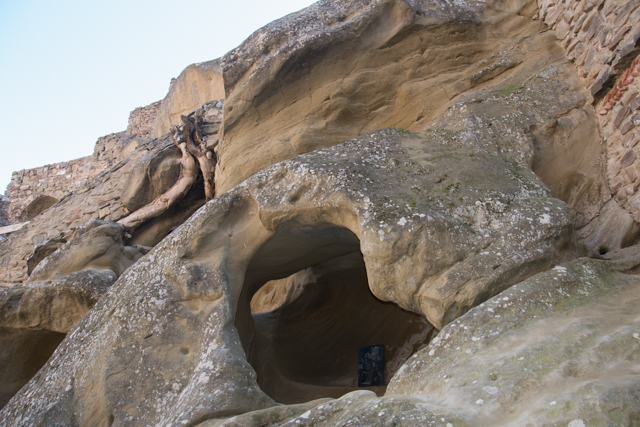
It is believed that Gareja chose this isolated area so that his disciples could devote themselves to monastic life without much influence from the rest of society.
Over the years
The greatest splendor of the monastery was in the 9th century, thanks to the patronage of the royal family and some nobles.
For centuries it was a important religious and cultural center, full of manuscripts, engravings and beautiful fresco paintings.
But not everything has been rosy for the monastery, which has suffered decline with the fall of the Georgian monarchy. Then it was devastated by the mongols in 1265 and rebuilt.

Remained closed during the Bolshevik government.
Furthermore, it was used as military training area during the Soviet-Afghan War and later by Georgian Ministry of Defense in 1996.
This monastery in its long history has seen them all.
Lavra Monastery
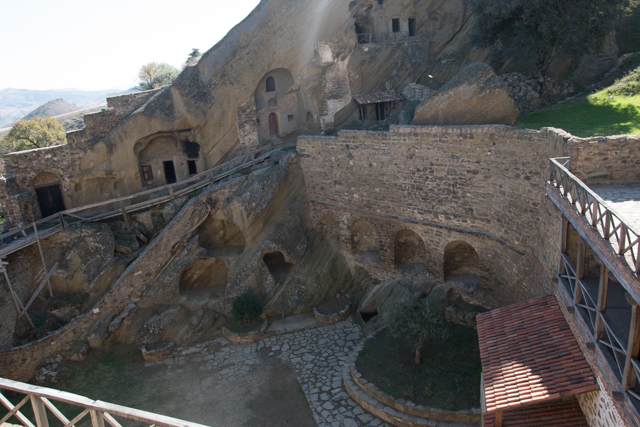
The Lavra monastery is the one on the Georgian side in a semi-desert area of the country.
This built on the same mountain rock and has 3 floors, with a church, refractory and It had up to 5,000 cells dug into the rock. where the monks lived.
Although a few caves remain standing, most are still in use as housing and, therefore, cannot be visited.
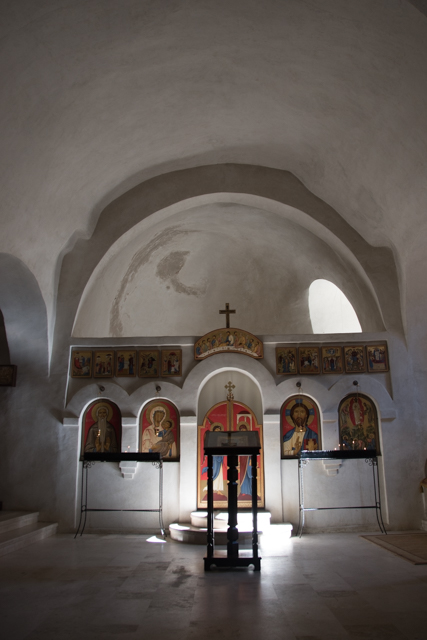
Another interesting thing about the monastery is its rainwater filtration system that is collected in one of the same caves.
Given the location of the monastery right on the border, a wall with its towers that still stand today.
The church has a beautiful bell tower that stands out and then inside The icons in the chapel draw attention.
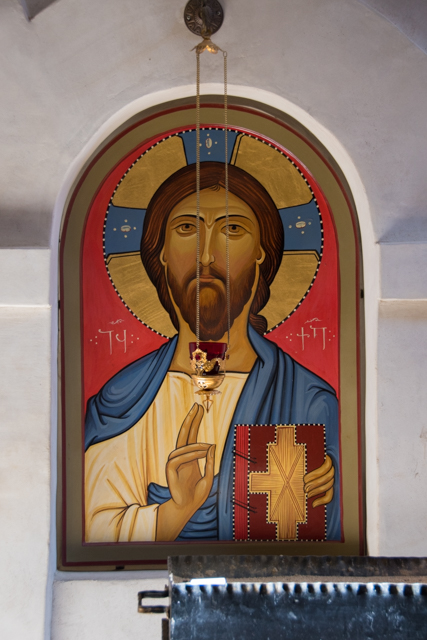
Udabno Monastery
Udabno Monastery is the one on the Azerbaijan side and is connected to Lavra by a trail.
However, In 2019 there was a dispute between Georgian activists and Azerbaijani border guards. Since then Azerbaijan closed the border and you can no longer cross it.
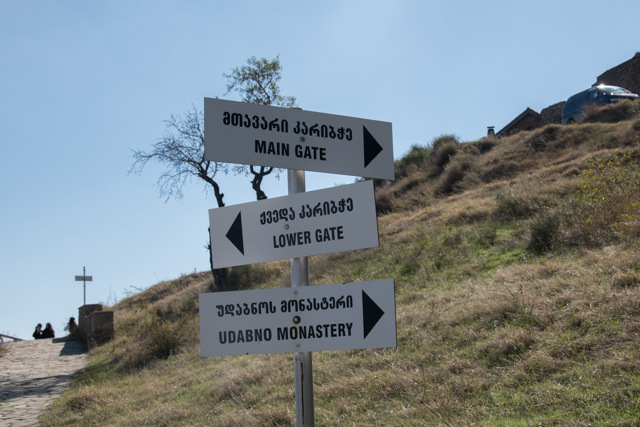
Therefore, the monastery of Udabno remains inaccessible to tourist visits until the disputes between both countries are resolved, which does not seem to be resolved in the short term.
Udabno is where they are found the most important frescoes of the complex, but we will have to wait to see if they can be visited in the future.
Rainbow Mountains
Another of the attractions of the area are the unique mountains in front of the Lavra monastery which are known as Rainbow Hills.
It is an almost lunar landscape with very particular undulations thanks to marine sedimentation belonging to the Miocene and Pliocene, that is, between 23 and 1.8 million years ago.
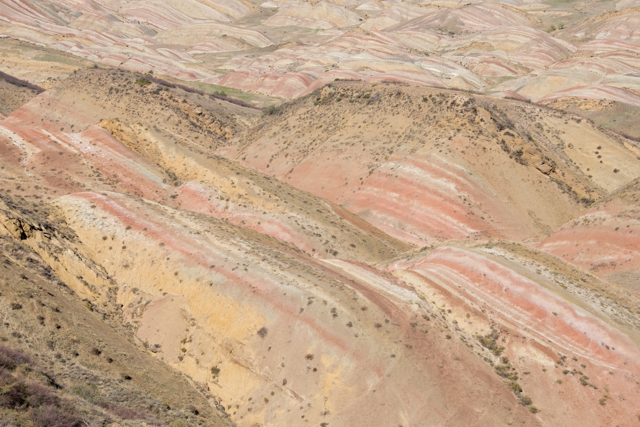
These sediments are also what give it its peculiar coloration and its name.
This is a very common area for small hiking routes, they are accessible from the parking lot of the David Gareja monastery and other nearby areas.
Although there are other larger colorful mountains in the area, I'll tell you more below.
What else to see in the area? (green on the map)
1.- Natlismtsemeli Monastery
Natlismtsemeli monastery also belongs to the David Gareja monastery complex and is 10 km from the Lavra.
This monastery is also known as that of San Juan or "the Baptist", founded by Luciane, one of the disciples of David Gareja.
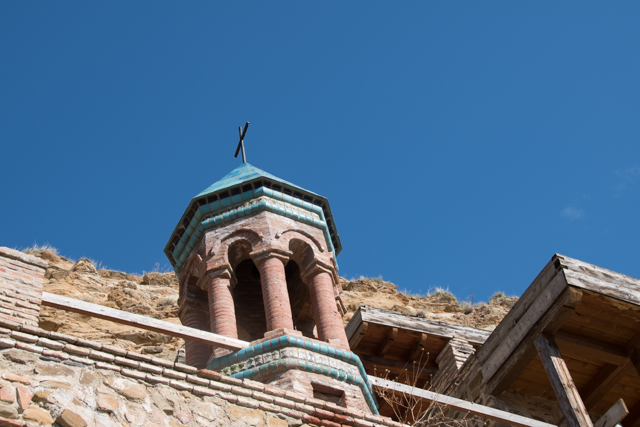
The monastery is located dug in the rocky area of the mountain, where Its church stands out, of considerable height to be a cave with a main area and a smaller one.
The iconostasis from the mid-18th century, worthy of admiration, although it is sad to see how damaged everything was after the invasions of this area.
The truth is that it is painful to see how something with so much history and value was scratched to ruin it.
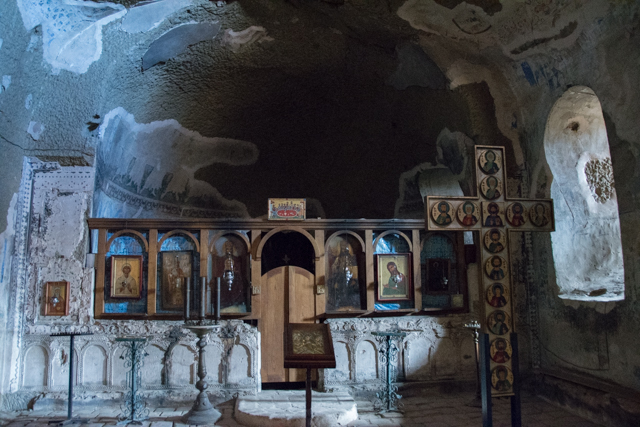
Other things that attract attention about the monastery are:
- The outer bell tower how quite beautiful;
- the caves that function as housing for the monks and are not visitable. Although some are in very bad condition and are empty;
- finally, you can climb the tower which has good views of the area, you have to follow the path that passes in front of the caves and surrounds the mountain, it will take you less than 10 minutes to get there. Then you can climb the tower passing through the small cave seen in the photo below.
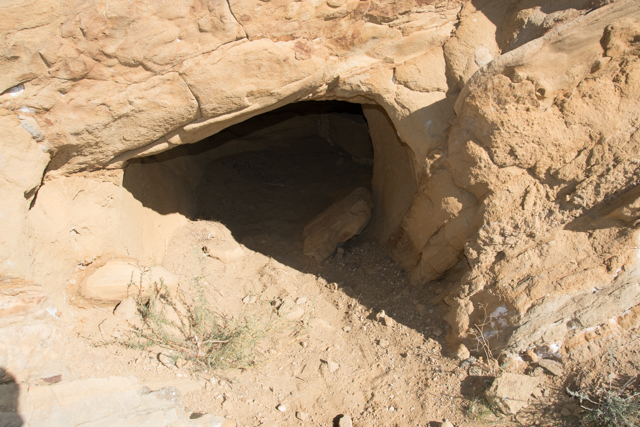
2.- Dodo Church
This church was built in an area of interconnected caves, is located just 12 km from the David Gareja Monastery.
Was founded by Dodo in the 6th century, another of David Gareja's disciples, although its construction lasted until the 18th century.
Like other monasteries in the area, suffered invasions and looting from both the Mongols as of the Safavid (the largest Iranian empire there ever was).
The most notable thing is the fresco on the central altar of the Blessing of Jesus, where the archangel Michael and Gabriel appear.
3.- Jandara Reservoir
The Jandara reservoir is 10.6 km long and It is located right on the border of Georgia and Azerbaijan.
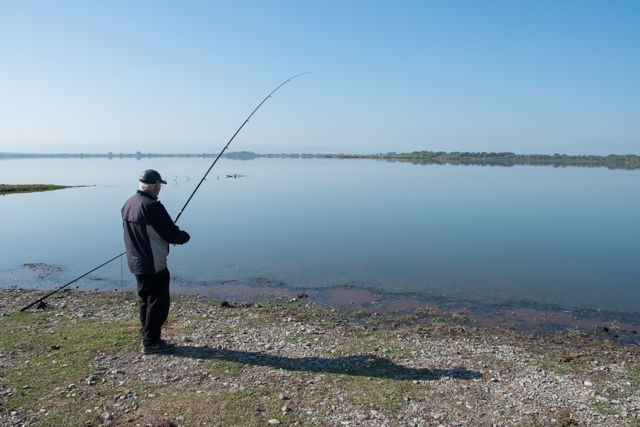
This large reservoir has areas of vegetation around it such as reeds and willows that attracts a wide variety of migratory waterfowl such as wild ducks and pelicans.
The area is very popular with locals as a fishing, picnicking and camping spot for its super quiet environment.
Keep in mind that in the last year there are people who have tried to camp there and the Border guards made them march before nightfall of the area.
4.- Mravaltskaro Reservoir
If you go on your own and want to add some more places without making too many stops, I recommend this reservoir that is next to the red mountains (from the next point).

This stop is the most striking of those you can make in the area after visiting the David Gareja monastery and it is a good area to finish the tour.
The reservoir is surrounded by rounded mountains, so characteristic of this area that at sunset they are reflected in its waters, perfect for taking some fabulous photos.
5.- Red mountains
On google maps you will see that these mountains are marked as Red Mountains.
However, this is the area that locals call the Rainbow Hills, despite the fact that the predominant color is red and those next to David Gareja are called “Colorful Mountains”, that is, Colorful Mountains.

Although, they have a smaller chromatic variety, the rounded shape is much more impressive that those who are next to Lavra and the brick red color gives it a lot of appeal.
To reach these red mountains you will have to walk along the side of the Mravaltskaro reservoir from the previous point and then continue along a path that will take you a few minutes (less than 10 min).
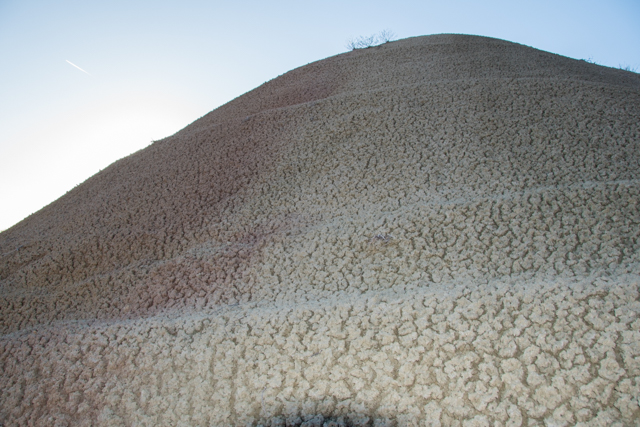
The part from the end of the reservoir to the beginning of the red mountains is along a narrow path that can be very slippery on rainy days.
In addition, there is a small section with a steep descent and then ascent that can be a little difficult for older people or very small children.
The rest of the way is easy and then you can walk through the red mountains.
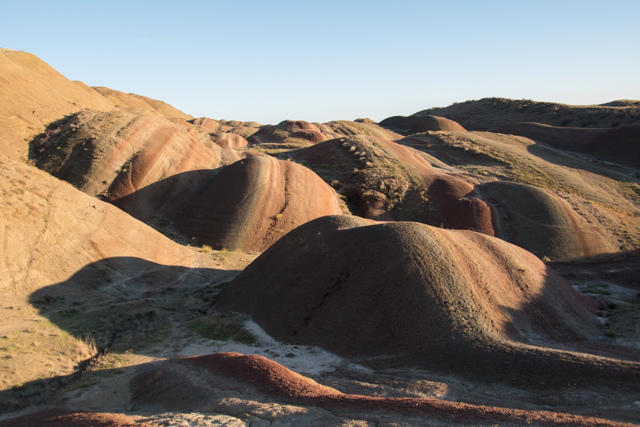
Map of David Gareja and surroundings
* To check the legend for each place, click the button in the top left corner of the map. To view this map on your phone or computer, tap the star on the right side of the title. Then go to Google Maps, select "Your Places" and "Maps" from the menu.
Tips for visiting the David Gareja monastery
1. Visiting season
The best times to visit the monastery is at the end of spring (April and May) and the beginning of autumn (September and October).
In summer, you can visit, but since it is a semi-arid area It's too hotIf you visit during this time, protect your skin.
Then in winter roads become inaccessible with snow and ice, cannot be visited.
2. Rain
The rain makes the dirt road impassable and hiking is almost impossible Because in the area of colorful mountains there is little vegetation and everything turns into very slippery mud.
Therefore, if you go on your own, avoid rainy days. If you go with an excursion, they will probably cancel it if it rains.
3. Snakes
In the area there are poisonous snakes like the rattlesnake in the photo (Levant Viper) and They are much more present and active during the summer months.
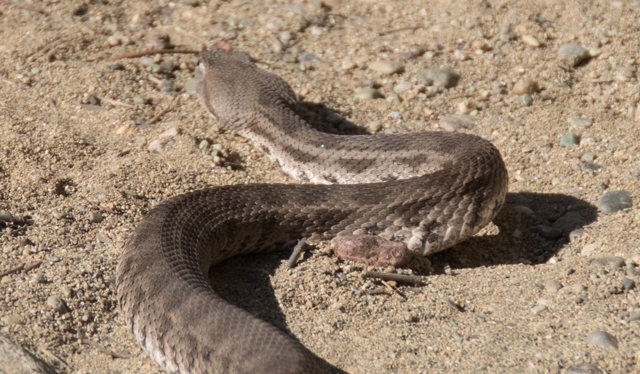
I recommend you to keep your distance if you see any and be careful where you put your hands. In particular, do not put your hands in any holes in the ground or move rocks with your hands.
Although in theory It is an aggressive species, the one you see in the photo, the poor thing hid right away.
4. Closed footwear
In this area you must wear closed shoes with a minimum of grip.
It will come in handy for any small hiking route you do. in the area, especially if it rained the night before, because the colorful mountains become slippery.
Another reason to wear closed shoes is danger of snakes.
5. Passport
Now that the border with Azerbaijan is closed, it is rare for the border guards there to ask for a passport.
But you must take it with you in case you have doubts or Georgian identification documentation if you are a resident.
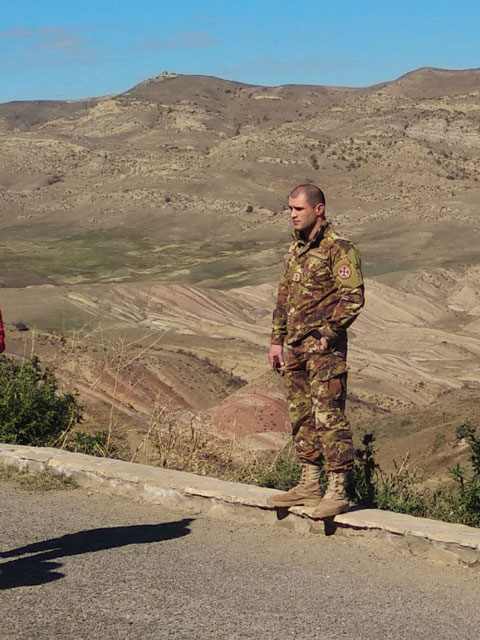
6. Water and snacks
Where is the Lavra monastery there is no restaurant or where to buy foodWhat they have for sale at the religious goods store is water.
It's a good idea though bring enough water and snacks with you, because at the other stops there is nowhere to buy anything.
If you go on an excursion, they usually stop along the way somewhere with a supermarket to buy water and food.
7. Carry coins
They will help you leave a donation, because monasteries and churches are free, but if it is within your means, leave something that will help them with the maintenance.
In addition, in the Lavra there are public toilets, but to enter you have to pay 50 tetris.
8. Border
The land borders between Georgia and Azerbaijan are closed at least until October 1, 2024. After that, we'll have to wait and see what the Azerbaijani authorities decide.
Azerbaijan put this measure in place during the pandemic and have been extending it every few months, supposedly due to COVID.
Right now, the only way you can visit Azerbaijan from Georgia is by plane. There are flights from Tbilisi to Baku.
If you are going to visit David Gareja, before venturing across the border into Azerbaijan, find out about the current situation.
Frequently asked questions about visiting David Gareja
Yes, the Lavra monastery and the Rainbow Hills are worth seeing. In addition, there are many more places to stop in the area.
No not at all. Although you will see the Georgian border guards, they are there doing their job and do not usually interact with tourists.
The most they can ask you is for you to show them your passport, they didn't ask me for it.
How to go to David Gareja?
1.- Car
If you are going to drive, you have the option of go in the direction of Rustavi. About 10 km after Rustavi the paved road ends and the adventure begins.
A dirt agricultural road begins that extends for 20 km.
The road itself is not bad and you don't need to go in a 4×4, but it doesn't allow you to go too fast.
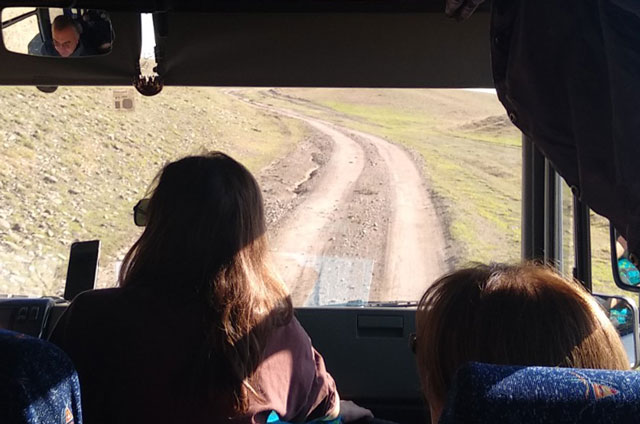
Yes indeed, During rainy days there are sections that are completely inaccessible and it is better that you postpone the visit.
Then the last 3 km to David Gareja Monastery are paved.
Another alternative is to take the road towards Sagarejo and then towards Udabno, there is also a good bit of dirt road, although apparently in a little better condition than after Rustavi.
It is best that you choose the path according to what you want to visit.
Yes indeed, Take a GPS because the roads are not markedIn that area, cell phone coverage is sometimes lost and there is no one to ask.
The best search engine for rent a car in Georgia This is it, which works only with local companies.
Therefore, they have very cheap prices and you can be sure that they are all serious companies.
2.- Gareji Line (cancelled for now)
To go to the Lavra monastery and the colorful mountains There is no public transportation, but there is a company that operates as a transfer service, is called Gareji Line (your facebook link).
This service runs every day from April to October (approximately, they post the beginning and then the end on Facebook), it costs 40 lari (13.74 euros) round trip, leaving from Pushkin Park next to Liberty Square.
Then there in the monastery They leave you 3 hours so you can visit quietly.
This service was going very well when you could cross to the Udabno monastery, but since the border closure 3 hours are excessive and they do not make any more stops.
3.- Excursion
One of the most practical alternatives is to go with an excursion that makes several stops and make the most of the day.
I highly recommend this full day tour which is the one I took, they take you to the Lavra Monastery, to the Natlismtsemeli (St. John) Monastery and then to the Mravaltskaro Reservoir and the Red Mountains.
More about Georgia and the Caucasus
- 24 things to see in Tbilisi
- 16 things to do and see on Batumi Boulevard
- 11 ideas of What to see in Borjomi, Georgia
- What to bring to Georgia?
- What to do in Yerevan: 14 best plans

Hi, I’m Andrea, creator and author of Viajeros Activos (Active Travelers). I write about Southeast Asia, the Caucasus, and Europe. I’m a full-time traveler, passionate about good food, and always looking for new adventures.
Hello Andrea
Thank you for this post, I found it very explanatory and clear.
My question is this, are there frescoes in the Lavra? Is it worth going to see this area?
I have seen quite expensive tours and that is why I am hesitant.
Thank you
Hello Kako
No, there are no frescoes in the Lavra, only what I explain in the article.
The main frescoes are in Udabno and then in other hermitages and monasteries belonging to David Gareja.
Unfortunately Udabno is still closed today.
There are cheaper tours like this one from the link, which take you to Lavra and the rainbow mountains.
But if I'm honest, for me that tour is not worth it, it's many hours of transportation for little to see. For this reason, I recommend the other tour that I took that has more visits. I really liked the Natlismtsemeli monastery, although the frescoes are very damaged, it is an interesting place to visit, the red mountains and the reservoir next to it are also beautiful.
By the way, if you have a special interest in frescoes, be sure to visit the Gelati monastery near Kutaisi, here is the link to article in case you haven't read it. They are the best fresh in Georgia and are stunning.
Have a good trip!